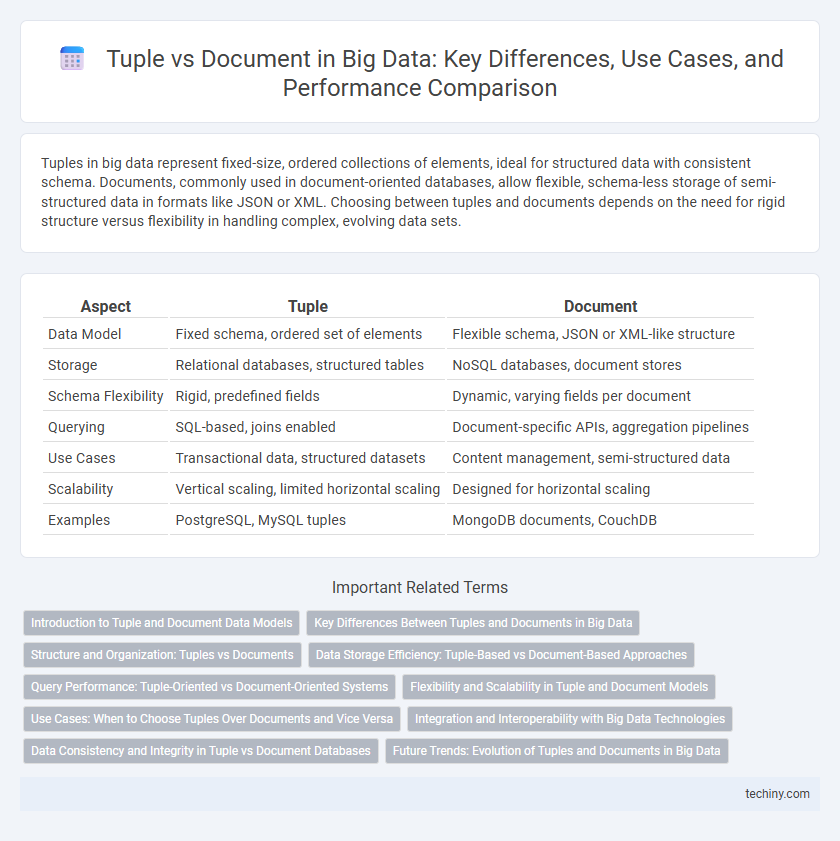Tuples in big data represent fixed-size, ordered collections of elements, ideal for structured data with consistent schema. Documents, commonly used in document-oriented databases, allow flexible, schema-less storage of semi-structured data in formats like JSON or XML. Choosing between tuples and documents depends on the need for rigid structure versus flexibility in handling complex, evolving data sets.
Table of Comparison
| Aspect | Tuple | Document |
|---|---|---|
| Data Model | Fixed schema, ordered set of elements | Flexible schema, JSON or XML-like structure |
| Storage | Relational databases, structured tables | NoSQL databases, document stores |
| Schema Flexibility | Rigid, predefined fields | Dynamic, varying fields per document |
| Querying | SQL-based, joins enabled | Document-specific APIs, aggregation pipelines |
| Use Cases | Transactional data, structured datasets | Content management, semi-structured data |
| Scalability | Vertical scaling, limited horizontal scaling | Designed for horizontal scaling |
| Examples | PostgreSQL, MySQL tuples | MongoDB documents, CouchDB |
Introduction to Tuple and Document Data Models
Tuple data models organize information in fixed schema records, commonly used in relational databases to store structured data efficiently through rows and columns. Document data models represent data as semi-structured documents, typically in JSON or XML formats, allowing flexible schemas suited for hierarchical and varied data types. Both models serve distinct purposes in big data environments, with tuples optimizing structured query performance and documents enabling agile handling of unstructured or evolving data.
Key Differences Between Tuples and Documents in Big Data
Tuples in Big Data represent fixed-size, ordered collections of elements typically used in relational databases for structured data storage and fast querying, while documents are flexible, schema-less records stored in document-oriented databases like MongoDB, optimized for unstructured or semi-structured data. Tuples rely on a strict schema and predefined data types, ensuring data consistency and integrity, whereas documents use JSON or BSON formats allowing nested data and varying fields, enhancing adaptability for diverse datasets. Performance-wise, tuples offer faster transactional processing in structured scenarios, and documents provide scalability and agility suited for Big Data applications requiring dynamic, evolving data models.
Structure and Organization: Tuples vs Documents
Tuples are fixed-schema data structures with a predefined number of attributes, optimized for relational databases and structured queries. Documents offer flexible, schema-less organization using key-value pairs, ideal for semi-structured or unstructured data in NoSQL databases. This structural difference influences data retrieval, with tuples favoring strict consistency and documents supporting dynamic, hierarchical data models.
Data Storage Efficiency: Tuple-Based vs Document-Based Approaches
Tuple-based data storage organizes information into fixed schema rows, optimizing storage efficiency for structured, relational datasets with predictable attributes. Document-based storage allows flexible, schema-less entries ideal for semi-structured or unstructured data but may introduce overhead due to metadata and variable document sizes. Efficiency in tuple storage benefits environments requiring fast, consistent transactions, while document storage excels in scalability and adaptability for heterogeneous big data sources.
Query Performance: Tuple-Oriented vs Document-Oriented Systems
Tuple-oriented systems excel in query performance for structured data through fixed schemas and efficient indexing, enabling rapid retrieval with predictable latency. Document-oriented systems offer flexible schemas, allowing complex, nested queries but sometimes sacrificing speed due to more extensive data parsing and traversal. Query optimization in tuple stores benefits from columnar storage and pre-aggregation, while document stores rely on indexing strategies tailored for hierarchical data access patterns.
Flexibility and Scalability in Tuple and Document Models
Tuple models provide structured, consistent data storage ideal for operations requiring fixed schema, but they often lack flexibility when adapting to varied or evolving data types. Document models offer enhanced flexibility by storing semi-structured data in JSON-like formats, enabling seamless schema evolution and easy handling of diverse data. Scalability in tuple systems is typically achieved through partitioning and indexing, whereas document models excel in horizontal scaling by distributing nested document data across clusters without strict schema constraints.
Use Cases: When to Choose Tuples Over Documents and Vice Versa
Tuples are ideal for scenarios requiring fixed-schema data storage with fast, atomic read and write operations, such as real-time analytics and transactional systems. Documents excel in handling semi-structured or unstructured data, making them suitable for content management, user profiles, and flexible schema evolution in applications like NoSQL databases. Choosing tuples over documents depends on the need for rigid schema and consistency, while documents are preferred for flexibility and complex hierarchical data storage.
Integration and Interoperability with Big Data Technologies
Tuples offer a rigid schema that ensures seamless integration with relational databases and stream-processing frameworks prevalent in Big Data ecosystems, promoting data consistency and faster query execution. Documents, with their flexible, schema-less JSON or BSON structures, enhance interoperability by easily accommodating diverse and evolving data types across NoSQL databases, data lakes, and distributed file systems. Leveraging tuples supports high-performance analytics in structured environments, whereas document formats excel in handling semi-structured or unstructured data crucial for AI-driven Big Data applications.
Data Consistency and Integrity in Tuple vs Document Databases
Tuple databases, often found in relational database systems, enforce strict data consistency and integrity through ACID (Atomicity, Consistency, Isolation, Durability) properties, ensuring reliable transaction processing and minimal data anomalies. Document databases, commonly used in NoSQL architectures, offer flexible schema designs and eventual consistency models, prioritizing scalability and performance but requiring application-level mechanisms to maintain data integrity. The choice between tuple and document databases depends on balancing the need for immediate consistency versus scalability and flexibility in handling diverse and evolving data structures.
Future Trends: Evolution of Tuples and Documents in Big Data
Tuples and documents continue to evolve as fundamental data structures in Big Data, driven by increasing demands for scalability and schema flexibility. Future trends indicate enhanced integration of tuple-based models with real-time analytics, while document-oriented databases are advancing support for complex nested data and multi-model capabilities. Innovations in AI and machine learning also leverage these structures for improved data interoperability and dynamic schema evolution in distributed systems.
Tuple vs Document Infographic

 techiny.com
techiny.com